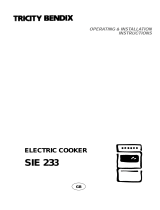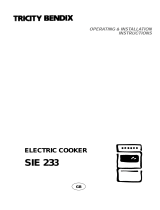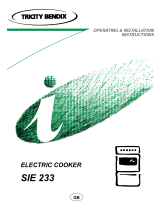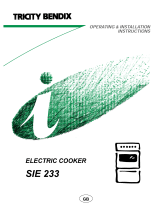
2
Keep this instruction book for future
reference and ensure it is passed on to
any new owner.
These instruction are only valid in the
countries whose symbols appear on this
booklet’s cover.
Important Safety Information
You MUST read these warnings carefully before installing or using the hob. If you need assistance,
contact our Customer Care Department.
ENGLISH
Installation
• The work of installation must be carried out by
competent and qualified installers according to the
regulations in force.
• Any modifications to the domestic electrical mains
which may be necessary for the installation of the
appliance should be carried out only by competent
personnel.
• Check your appliance for any transport damage.
• Never connect a damaged appliance. If your appliance
is damaged, contact your supplier.
• It is dangerous to modify, or attempt to modify, the
characteristics of this appliance.
• Avoid installation of the appliance near inflammable
material (e.g. curtains, tea towels, etc.).
• This appliance is heavy. Take care when moving it.
• This appliance cannot be positioned on a base.
• Remove all packaging before using the appliance.
• Some parts have a shock-resistant plastic film
protection. Be sure to remove this plastic film before
you start operating the appliance and clean the parts
involved using a soft cloth wrung out in warm water
to which a little washing up liquid has been added.
• Ensure that the electrical supply complies with the
type stated on the rating plate.
Child Safety
• This appliance is designed to be operated by adults.
Do not allow children to play near or with the
appliance.
• The appliance gets hot when it is in use. Children
should be kept away until it has cooled.
• Children can also injure themselves by pulling pans
or pots off the appliance.
During Use
• This appliance is intended for domestic cooking only.
It is not designed for commercial or industrial
purposes.
• Do not use this appliance if it is in contact with water.
• Do not operate the appliance with wet hands.
• Ensure the control knobs are in the ‘OFF’ position
when not in use.
• During use the appliance becomes hot. Care should
be taken to avoid touching heating elements inside
the oven.
• Always stand back from the oven when opening the
oven door, to allow any build-up of steam or heat to
release.
• When using other electrical appliances, ensure the
cable does not come into contact with the hot
surfaces of the appliance.
• Never use the hob as a working space. Do not store
things on the hob.
• Never use plastic or aluminium foil dishes on the hob.
• Never use plastic dishes in the oven.
Never line any
part of the oven with aluminium foil.
• Unstable or misshapen pans should not be used on
the cooking zones as unstable pans can cause an
accident by tipping or spillage.
• Never leave the appliance unattended when cooking
with oil and fats.
• This appliance should be kept clean at all times. A
build-up of fats or foodstuffs could result in a fire.
• Always ensure that the oven vent which is located at
the centre back of the hob is left unobstructed to
ensure ventilation of the oven cavity.
• Perishable food, plastic items and areosols may be
affected by heat and should not be stored above the
appliance.
•
Only heat-resistant plates may be placed in the
drawer situated under the oven. Do not p ut
combustible materials there.
• Never use steam or high pressure steam cleaners to
clean the appliance.
Service
• This appliance should only be repaired or serviced by
an authorised Service Engineer and only genuine
approved spare parts should be used.
























